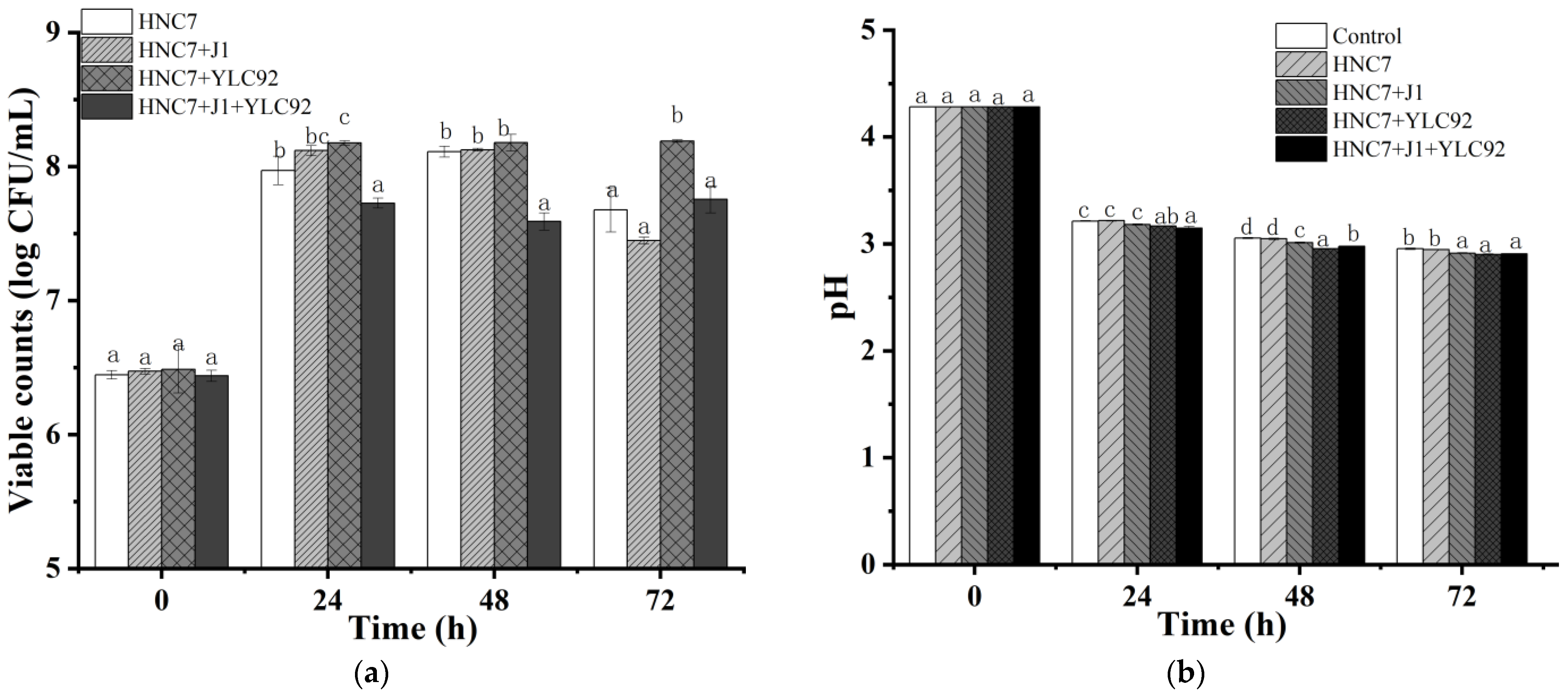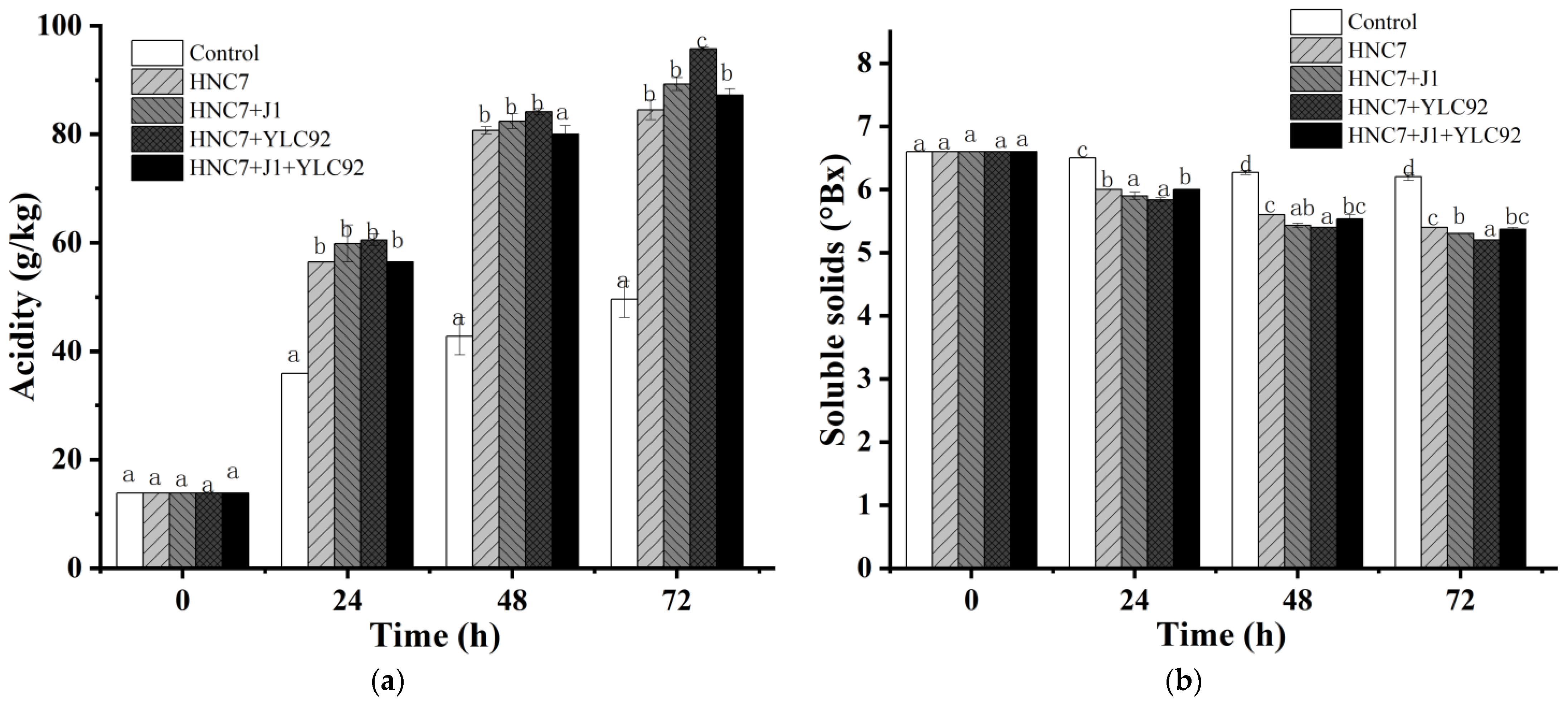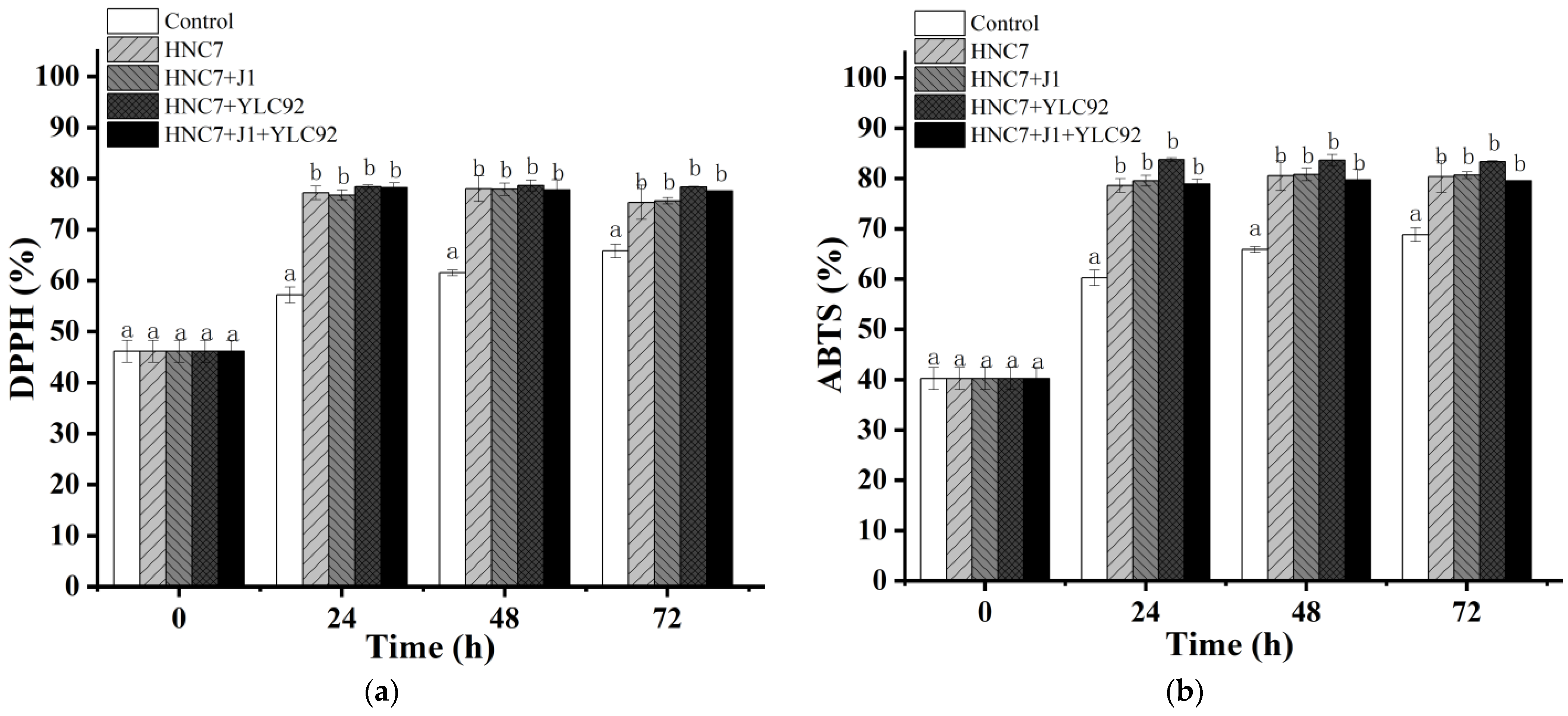Lactobacillus HNC7-YLC92 Improves the Fermentation Quality of Cassava–Acerola Cherry Beverage
Abstract
1. Introduction
2. Materials and Methods
2.1. Microorganisms and Culture Conditions
2.2. Preparation of Cassava-Acerola Cherry Juice
2.3. Fermentation
2.4. Viable Count and pH Measurement
2.5. Acidity and Soluble Solids
2.6. Determination of Organic Acids and Sugars
2.7. Volatile Analysis
2.8. Ascorbic Acid Content
2.9. Antioxidant Activity
2.10. Statistical Analysis
3. Results and Discussion
3.1. Bacterial Growth and Changes of pH during Fermentation
3.2. Acidity and Soluble Solids
3.3. Sugars and Organic Acids
3.4. Volatile Analysis
3.5. Ascorbic Acid Content
3.6. Antioxidant Activity
4. Conclusions
Author Contributions
Funding
Institutional Review Board Statement
Informed Consent Statement
Data Availability Statement
Conflicts of Interest
References
- Guimaraes Junior, M.; Teixeira, F.G.; Denzin Tonoli, G.H. Effect of the nano-fibrillation of bamboo pulp on the thermal, structural, mechanical and physical properties of nanocomposites based on starch/poly(vinyl alcohol) blend. Cellulose 2018, 25, 1823–1849. [Google Scholar] [CrossRef]
- Letif, S.; Muller, J. Potential of cassava leaves in human nutrition: A review. Trends Food Sci. Technol. 2015, 44, 147–158. [Google Scholar] [CrossRef]
- De Dea Lindner, J.; Penna, A.; Demiate, I.; Yamaguishi, C.T.; Prado, M.R.M.; Parada, J.L. Fermented Foods and Human Health Benefits of Fermented Functional Foods. In Fermentation Processes Engineering in the Food Industry; CRC Press: Boca Raton, FL, USA, 2013; pp. 263–297. [Google Scholar] [CrossRef]
- Qiao, H.H.; Chen, L.W.; Yang, J.S.; Zhi, W.B.; Chen, R.; Lu, T.Y.; Tan, H.S.; Sheng, Z.W. Effect of Lactic Acid Bacteria on Bacterial Community Structure and Characteristics of Sugarcane Juice. Foods 2022, 11, 3134. [Google Scholar] [CrossRef]
- Kaur, H.; Kaur, G.; Ali, S.A. Dairy-Based Probiotic-Fermented Functional Foods: An Update on Their Health-Promoting Properties. Fermentation 2022, 8, 425. [Google Scholar] [CrossRef]
- Freire, A.L.; Ramos, C.L.; Schwan, R.F. Microbiological and chemical parameters during cassava based-substrate fermentation using potential starter cultures of lactic acid bacteria and yeast. Food Res. Int. 2015, 76, 787–795. [Google Scholar] [CrossRef] [PubMed]
- Hashemi, S.M.B.; Jafarpour, D. Fermentation of bergamot juice with Lactobacillus plantarum strains in pure and mixed fermentations: Chemical composition, antioxidant activity and sensorial properties. LWT-Food Sci. Technol. 2020, 131, 109803. [Google Scholar] [CrossRef]
- Tkacz, K.; Chmielewska, J.; Turkiewicz, I.P.; Nowicka, P.; Wojdylo, A. Dynamics of changes in organic acids, sugars and phenolic compounds and antioxidant activity of sea buckthorn and sea buckthorn-apple juices during malolactic fermentation. Food Chem. 2020, 332, 127382. [Google Scholar] [CrossRef]
- Mousavi, Z.E.; Mousavi, S.M.; Razavi, S.H.; Hadinejad, M.; Emam-Djomeh, Z.; Mirzapour, M. Effect of Fermentation of Pomegranate Juice by Lactobacillus plantarum and Lactobacillus acidophilus on the Antioxidant Activity and Metabolism of Sugars, Organic Acids and Phenolic Compounds. Food Biotechnol. 2013, 27, 1–13. [Google Scholar] [CrossRef]
- Freire, A.L.; Ramos, C.L.; de Almeida, E.G.; Duarte, W.F.; Schwan, R.F. Study of the physicochemical parameters and spontaneous fermentation during the traditional production of yakupa, an indigenous beverage produced by Brazilian Amerindians. World J. Microbiol. Biotechnol. 2014, 30, 567–577. [Google Scholar] [CrossRef]
- Huang, J.M.; Yang, J.S.; Tang, K.; Yang, T.S.; Tan, H.S. A study on the factors influencing the preservation rate of ascorbic acid in acerola cherry pulp. Food Sci. Technol. 2022, 42, e16322. [Google Scholar] [CrossRef]
- Song Bei, Y.J.; Tang, K.; Tan, H.; Wu, Y. Technology optimization and quality analysis of fermented cassava-acerola cherry beverage. China Brew. 2021, 40, 90–94. [Google Scholar] [CrossRef]
- Wojdylo, A.; Nowicka, P.; Babelewski, P. Phenolic and carotenoid profile of new goji cultivars and their anti hyperglycemic, anti-aging and antioxidant properties. J. Funct. Foods 2018, 48, 632–642. [Google Scholar] [CrossRef]
- Hu, R.; Gan, X.; Dong, W.; Long, Y.; Zong, Y.; Chu, Z. Influence of Different Exogenous Fermentable Sugars and Amino Acids on Flavor and Sensory Quality of Coffee Pulp Wine. Chin. J. Trop. Crops 2020, 41, 1208–1218. [Google Scholar]
- Hashemi, S.M.B.; Khaneghah, A.M.; Barba, F.J.; Nemati, Z.; Shokofti, S.S.; Alizadeh, F. Fermented sweet lemon juice (Citrus limetta) using Lactobacillus plantarum LS5: Chemical composition, antioxidant and antibacterial activities. J. Funct. Foods 2017, 38, 409–414. [Google Scholar] [CrossRef]
- Kedia, G.; Wang, R.; Patel, H.; Pandiella, S.S. Use of mixed cultures for the fermentation of cereal-based substrates with potential probiotic properties. Process Biochem. 2007, 42, 65–70. [Google Scholar] [CrossRef]
- Camps, C.; Robic, R.; Bruneau, M.; Laurens, F. Rapid determination of soluble solids content and acidity of Black currant (Ribes nigrum L.) juice by mid-infrared spectroscopy performed in series. LWT-Food Sci. Technol. 2010, 43, 1164–1167. [Google Scholar] [CrossRef]
- Conidi, C.; Cassano, A.; Drioli, E. A membrane-based study for the recovery of polyphenols from bergamot juice. J. Membr. Sci. 2011, 375, 182–190. [Google Scholar] [CrossRef]
- Xiao, M.; Xiong, T.; Peng, Z.; Liu, C.; Huang, T.; Yu, H.; Xie, M. Correlation between microbiota and flavours in fermentation of Chinese Sichuan Paocai. Food Res. Int. 2018, 114, 123–132. [Google Scholar] [CrossRef] [PubMed]
- Song, B.; Tan, H.S.; Yang, J.S. Effect of three drying methods on the drying kinetics and quality of acerola cherry. J. Food Process. Preserv. 2020, 44, e14674. [Google Scholar] [CrossRef]
- Lu, Q.; Peng, Y.; Zhu, C.H.; Pan, S.Y. Effect of thermal treatment on carotenoids, flavonoids and ascorbic acid in juice of orange cv. Cara Cara. Food Chem. 2018, 265, 39–48. [Google Scholar] [CrossRef] [PubMed]
- Hur, S.J.; Lee, S.Y.; Kim, Y.C.; Choi, I.; Kim, G.B. Effect of fermentation on the antioxidant activity in plant-based foods. Food Chem. 2014, 160, 346–356. [Google Scholar] [CrossRef] [PubMed]
- Randhir, R.; Vattem, D.; Shetty, K. Solid-state bioconversion of fava bean by Rhizopus oligosporus for enrichment of phenolic antioxidants and l-DOPA. Innov. Food Sci. Emerg. Technol. 2004, 5, 235–244. [Google Scholar] [CrossRef]
- Lee, I.H.; Hung, Y.H.; Chou, C.C. Solid-state fermentation with fungi to enhance the antioxidative activity, total phenolic and anthocyanin contents of black bean. Int. J. Food Microbiol. 2008, 121, 150–156. [Google Scholar] [CrossRef]
- Kachouri, F.; Ksontini, H.; Kraiem, M.; Setti, K.; Mechmeche, M.; Hamdi, M. Involvement of antioxidant activity of Lactobacillus plantarum on functional properties of olive phenolic compounds. J. Food Sci. Technol. 2015, 52, 7924–7933. [Google Scholar] [CrossRef] [PubMed]
- Zheng, J.S.; Wittouck, S.; Salvetti, E.; Franz, C.M.A.P.; Harris, H.M.B.; Mattarelli, P.; O’Toole, P.W.; Pot, B.; Vandamme, P.; Walter, J.; et al. A taxonomic note on the genus Lactobacillus: Description of 23 novel genera, emended description of the genus Lactobacillus Beijerinck 1901, and union of Lactobacillaceae and Leuconostocaceae. Int. J. Syst. Evol. Microbiol. 2020, 70, 2782–2858. [Google Scholar] [CrossRef] [PubMed]




| Sugars (g/L) | Organic Acids (g/100 mL) | ||||||||
|---|---|---|---|---|---|---|---|---|---|
| Fructose | Glucose | Sucrose | Maltose | Malic Acid | Lactic Acid | Citric Acid | Succinic Acid | ||
| Control | 0.59 ± 0.01 a | 1.79 ± 0.04 a | 0.28 ± 0.03 a | 0.96 ± 0.01 a | 1.34 ± 0.12 e | Nd | 0.55 ± 0.00 f | 0.05 ± 0.01 b | |
| group A | 24 h | 0.21 ± 0.02 b | 1.38 ± 0.02 bcd | 0.20 ± 0.01 b | 0.91 ± 0.00 b | 1.92 ± 0.08 f | 4.66 ± 0.04 b | 0.11 ± 0.03 d | 0.01 ± 0.00 a |
| 48 h | 0.11 ± 0.01 d | 1.32 ± 0.03 def | 0.19 ± 0.01 b | 0.87 ± 0.01 bcde | 0.88 ± 0.01 bcd | 5.84 ± 0.02 c | 0.09 ± 0.01 bcd | 0.01 ± 0.00 a | |
| 72 h | 0.06 ± 0.01 e | 1.30 ± 0.03 f | 0.20 ± 0.01 b | 0.86 ± 0.02 de | 0.97 ± 0.07 bcd | 6.89 ± 0.15 f | 0.03 ± 0.02 ab | 0.00 ± 0.00 a | |
| group B | 24 h | 0.19 ± 0.01 b | 1.35 ± 0.01 bcdef | 0.19 ± 0.01 b | 0.90 ± 0.00 bc | 1.78 ± 0.27 f | 4.52 ± 0.12 b | 0.22 ± 0.04 e | 0.01 ± 0.00 a |
| 48 h | 0.10 ± 0.00 d | 1.37 ± 0.03 bcde | 0.20 ± 0.01 b | 0.87 ± 0.00 bcde | 0.92 ± 0.00 bcd | 6.37 ± 0.00 de | 0.04 ± 0.01 abc | 0.01 ± 0.00 a | |
| 72 h | 0.08 ± 0.01 de | 1.31 ± 0.01 ef | 0.17 ± 0.01 b | 0.85 ± 0.01 de | 0.73 ± 0.01 bc | 6.37 ± 0.00 de | 0.02 ± 0.01 ab | 0.00 ± 0.00 a | |
| group C | 24 h | 0.19 ± 0.01 b | 1.35 ± 0.01 bcdef | 0.17 ± 0.01 b | 0.88 ± 0.02 bcde | 1.87 ± 0.02 f | 4.52 ± 0.03 b | 0.12 ± 0.06 d | 0.01 ± 0.00 a |
| 48 h | 0.10 ± 0.00 d | 1.34 ± 0.01 cdef | 0.18 ± 0.00 b | 0.86 ± 0.00 cde | 0.86 ± 0.01 bcd | 6.05 ± 0.03 cd | 0.11 ± 0.00 d | 0.01 ± 0.00 a | |
| 72 h | 0.06 ± 0.00 e | 1.31 ± 0.01 ef | 0.17 ± 0.00 b | 0.84 ± 0.00 e | 1.17 ± 0.04 de | 7.44 ± 0.01g | 0.01 ± 0.00 a | 0.00 ± 0.00 a | |
| group D | 24 h | 0.20 ± 0.01 b | 1.41 ± 0.00 b | 0.18 ± 0.12 b | 0.89 ± 0.04 bcd | 0.65 ± 0.23 ab | 3.85 ± 0. 19 a | 0.11 ± 0.01 cd | 0.01 ± 0.00 a |
| 48 h | 0.14 ± 0.01 c | 1.41 ± 0.00 b | 0.19 ± 0.01 b | 0.88 ± 0.00 bcde | 1.04 ± 0.04 cde | 6.66 ± 0.06 ef | 0.09 ±0.01 bcd | 0.00 ± 0.00 a | |
| 72 h | 0.08 ± 0.01 de | 1.39 ± 0.01 bc | 0.19 ± 0.01 b | 0.86 ± 0.00 cde | 0.38 ± 0.06 a | 6.44 ± 0.28 e | 0.01 ± 0.00 a | 0.00 ± 0.00 a | |
| Volatile Compounds | Control | Group A | Group B | Group C | Group D |
|---|---|---|---|---|---|
| Alcohols (mg/L) | |||||
| 3-Methyl-3-buten-1-ol | Nd | 1.75 ± 0.23 a | 1.47 ± 0.28 a | 1.85 ± 0.39 a | 1.19 ± 0.15 a |
| Prenol | Nd | 2.22 ± 0.00 a | 1.64 ± 0.35 a | 1.67 ± 0.10 a | 1.64 ± 0.30 a |
| Linalool | Nd | 1.79 ± 0.03 a | 1.78 ± 0.35 a | 3.04 ± 1.30 a | 1.66 ± 0.31 a |
| 1-Octanol | 0.52 ± 0.00 a | 1.21 ± 0.00 b | 0.68 ± 0.18 a | 0.87 ± 0.16 ab | 0.51 ± 0.04 a |
| 2-Furanmethanol | 0.94 ± 0.07 a | 0.97 ± 0.13 a | 0.90 ± 0.20 a | 1.94 ± 0.59 b | 0.87 ± 0.17 a |
| Benzyl alcohol | 0.83 ± 0.00 a | 0.72 ± 0.14 a | 0.57 ± 0.05 a | 4.53 ± 2.12 b | 0.76 ± 0.18 a |
| Phenylethyl alcohol | 1.63 ± 0.22 b | 0.82 ± 0.13 a | 0.81 ± 0.13 a | 0.69 ± 0.11 a | 0.77 ± 0.12 a |
| Octaethylene glycol | 1.34 ± 0.00 a | 1.37 ± 0.13 a | 1.02 ± 0.00 a | 3.13 ± 0.25 b | Nd |
| Esters (mg/L) | |||||
| Isobornyl acrylate | 5.09 ± 0.59 a | 3.76 ± 1.20 a | 4.23 ± 1.15 a | 5.06 ± 0.61 a | 4.05 ± 1.00 a |
| 1,2-Benzenedicarboxylic acid,bis(2-methylpropyl) ester | Nd | 2.12 ± 0.00 a | 2.63 ± 0.00 a | Nd | Nd |
| Isobornyl propionate | Nd | 4.65 ± 0.10 a | 3.47 ± 0.12 a | Nd | Nd |
| Chloroformic acid n-nonyl ester | Nd | Nd | Nd | Nd | 1.38 ± 0.2 |
| 1,2-Benzenedicarboxylic acid, butyl 2-methylpropyl ester | Nd | Nd | 0.03 ± 0.2 | Nd | Nd |
| Dibutyl phthalate | 0.85 ± 0.00 a | 0.68 ± 0.12 a | Nd | Nd | Nd |
| Acids (mg/L) | |||||
| Acetic acid | Nd | 5.06 ± 0.00 a | 3.86 ± 0.95 a | 2.59 ± 0.84 a | 4.14 ± 0.66 a |
| Nonanoic acid | Nd | 3.42 ± 0.12 a | 3.41 ± 0.12 a | Nd | Nd |
| 2,6-Di-tert-butyl-4-hydroxy-4-methylcyclohexa-2,5-dien-1-one | 1.18 ± 0.10 a | Nd | 0.50 ± 0.00 a | 3.13 ± 1.83 a | 0.28 ± 0.07 a |
| Acetoin | Nd | Nd | 1.13 ± 0.00 a | Nd | 0.70 ± 0.09 a |
| Phenolics(mg/L) | |||||
| 4-Vinylguaiacol | 0.46 ± 0.00 | Nd | Nd | Nd | Nd |
| 2,4-Di-tert-butylphenol | 52.09 ± 2.61 b | 25.97 ± 2.63 a | 29.34 ± 4.29 a | 34.84 ± 10.14 ab | 27.80 ± 9.34 a |
| Butylphen | 0.26 ± 0.00 a | Nd | Nd | Nd | 0.19 ± 0.00 a |
Disclaimer/Publisher’s Note: The statements, opinions and data contained in all publications are solely those of the individual author(s) and contributor(s) and not of MDPI and/or the editor(s). MDPI and/or the editor(s) disclaim responsibility for any injury to people or property resulting from any ideas, methods, instructions or products referred to in the content. |
© 2024 by the authors. Licensee MDPI, Basel, Switzerland. This article is an open access article distributed under the terms and conditions of the Creative Commons Attribution (CC BY) license (https://creativecommons.org/licenses/by/4.0/).
Share and Cite
Lu, T.; Song, B.; Yang, J.; Tan, H.; Qiao, H.; Zhi, W.; Chen, R.; Sheng, Z. Lactobacillus HNC7-YLC92 Improves the Fermentation Quality of Cassava–Acerola Cherry Beverage. Fermentation 2024, 10, 90. https://doi.org/10.3390/fermentation10020090
Lu T, Song B, Yang J, Tan H, Qiao H, Zhi W, Chen R, Sheng Z. Lactobacillus HNC7-YLC92 Improves the Fermentation Quality of Cassava–Acerola Cherry Beverage. Fermentation. 2024; 10(2):90. https://doi.org/10.3390/fermentation10020090
Chicago/Turabian StyleLu, Tianyu, Bei Song, Jinsong Yang, Haisheng Tan, Huahua Qiao, Wenbo Zhi, Rong Chen, and Zhanwu Sheng. 2024. "Lactobacillus HNC7-YLC92 Improves the Fermentation Quality of Cassava–Acerola Cherry Beverage" Fermentation 10, no. 2: 90. https://doi.org/10.3390/fermentation10020090
APA StyleLu, T., Song, B., Yang, J., Tan, H., Qiao, H., Zhi, W., Chen, R., & Sheng, Z. (2024). Lactobacillus HNC7-YLC92 Improves the Fermentation Quality of Cassava–Acerola Cherry Beverage. Fermentation, 10(2), 90. https://doi.org/10.3390/fermentation10020090






